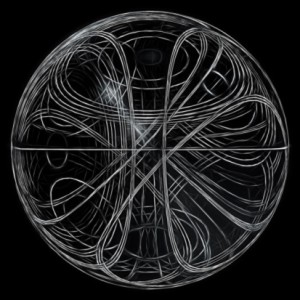Determinism and Freewill are Brothers (Part 2)
By Asher Crispe: April 29, 2011: Category Decoding the Tradition, Inspirations
This world of ours seems to be overwhelming with the choices that are presented to us. With literally billions of products to choose from we sometimes feel paralyzed by choice. Having no limits in fact, presents the problem that Barry Schwartz has termed and titled a book: The Paradox of Choice. The gist of his argument is that we cannot process all the choices we are given, particularly when it comes to the never ending barrage of material objects.
There is something about having thousands of window drape patterns to choose from that threatens to tie us up for days, weeks, perhaps even years trying to decide between them.
As a result, we may come to find, as Schwartz suggests, that the way out of the tyranny of choice is to embrace ‘choice within constraints’ or ‘freedom within limits.’ Given the analysis of our previous article, this would suggest that in the end Kayin and Hevel will have to learn to get along and live together.
Inasmuch as Kayin provides limits to Hevel, we may come to see the freewill of Hevel in a more circumscribed way. He will become the embodiment of freewill within limits of the Divine plan. Likewise, Kayin becomes a Divine plan (or metaphysical determinism if you like) that incorporates freewill. It is like saying that we devised an interactive design that anticipates all sorts of free choices by end users and reacts accordingly. The plan can handle improvisation and adaption. The code is set up to be reprogramed.
Moreover—and this is the curve ball that may or may not unravel the paradox—the programmer is also the user. As with our bus analogy, the driver is also a passenger on the bus. For the mystics, God is not alongside of Creation but is within creation as well. Thus there is no split between us and the Divine from a certain perspective. Our freewill has to do with the Godliness within us—the very same Godliness that provides for Divine Providence.
All of the preceding discussion sets the stage for the following enigmatic remark of the rabbis of antiquity (Kohelet Rabbah 11:8): “The Torah which a person learns in this world is vanity (literally hevel) in comparison to (lefnai literally ‘before’) the Torah of Moshiach (Messiah).” This view is consistent with the rabbinic notion that Moshiach will reveal yet another dimension from within the self-same Torah as we have it today. This new revelation is called Torah chadasha or new (innovative understanding of) Torah in that it presents a previously concealed mystical strata of the text for the first time in a manner that is accessible to all.
The Arizal, however, puts an entirely different spin on this statement. Instead of understanding the word hevel as vanity, he reads it as Hevel (Abel) the person. This world (olam hazeh) is a world dominated by the concerns of Hevel. By contrast, the world to come (olam habah) refers to the messianic age wherein Moshiach will teach the Torah of Kayin (Cain).
So what practically does this mean? Since, we have already described how Hevel represents the idea of freewill, it follows that the major thrust of this world, in the course of history, is the Torah (teaching) of decision or choice theory. It’s all about how to make good choices and provide aid to our decisions with which we navigate through life. In decision theory, there is an almost implicit assumption that this is no (rigid) determinism, no predefined plan. We also speak of probabilities and game theory in this manner.
That being said, the Torah of Moshiach, or which is called the Torah of Kayin—meaning that it is inclined to regard reality from the perspective of Kayin which is to see everything as Divine Providence—belongs to the future or the world to come. In a sense, this dimension of Torah serves to illustrate the grand design of an elegant universe.
Moshiach has to fill in the explanatory gaps in the message of Creation. Why did everything need to happen this way in order to arrive at the desired end result? How was everything all part of the plan that was Divinely orchestrated from start to finish?
Part of picking up on the superabundance of synchronicities in life, comes from having all the required information accessible. Since the process of history is still happening, it follows that some of the information will only be available in the future. With incomplete information we will be frustrated in our attempts to put together a comprehensive picture. Once we can access a sufficient quantity of the requisite information, we can begin to construct a composite image off all of that information and draw conclusions about the interrelationships contained therein.
The ability to network together and search all of the world’s information is central to the ‘Torah’ of the messianic age. Since this is a time which is compared to the Sabbath (Shabbat) we may evoke a custom of the sages for whom it was not only permissible but advantageous to taste from the food of the Sabbath before the Sabbath arrives. Analogous to this, we are today tasting the Torah of the messianic age in the sense that the mystical teachings of Chassidic philosophy are said to be a precursor to Torah teachings of Moshiach. Likewise, the exponential growth of the internet and the concomitant flood of information is providing an extremely visceral preview of the world to come.
Returning to the original statement, we find that the relationship marked out between the Torah teaching of this world (choice theory) and the world to come (everything by design) is one of comparison. The world used to denote the comparison is lefnai which can also means ‘in face of’, ‘before’ (antecedent) or even interior to (penai ‘face’ as well as penimiyut ‘interiority’ being associate words). Thus, the Torah of Hevel is inside of the Torah of Kayin in the sense that it is the inner content. Working with the amalgamated decisions presents the material for study and networking within the framework of the Torah of Kayin.
Design thinking (Kayin) will have to incorporate all of the choices and games (Hevel) experienced along the way. According to Jewish tradition this will bring peace and wholeness to the world. The word for peace in Hebrew is shalom which also carries the connotation of heshlim, to make whole or to complete. This is where the idea of filling in the explanatory gaps comes in.
For most of us, reading the Torah in the customary fashion presents endless difficultly in terms of putting all of the various perspectives and ideas together into any kind of coherent whole. Sometimes, with a lot of learning, we may intuit the wholeness to the design of Creation within the blueprint of the Torah, but explanatory gaps persist. This makes it impossible to completely close the distance between the real world and the one depicted in the Torah through its mystical dimensions.
As the Sages tell us, the Torah prior to the messianic age remains still ten hands breaths above the earth. This symbolizes the parallax gap between representation and reality, theory and practice, formal learning and real life. However slight, this interval is more than enough to lose the meaning and intent that we are seeking to display with the unveiling of the completed design in the world to come.
 Finally a word about these worlds.
Finally a word about these worlds.
This world and the world to come are not separate realms or alternative universes set apart by hidden dimensions, be they spiritual or physical. Rather, they denote two frameworks for understanding reality that are in simultaneous operation at all times.
This world (olam hazeh) refers to the world of discrete objects, to the world of separation, a world populated by things that seem to exist in and of themselves in a disconnected fashion. As for the world to come (olam haba), it underscores the idea of life as a series of processes. Sometimes we speak of the ‘coming’ as a pehulah nimsheket or a continuous action. Meaning, that the world to come is really a world or frame of reference which is continuously coming. Becoming replaces being. This turns the messianic age—which is often called the coming of the messiah (Moshiach)—into an ongoing process. There are many phases to this process that are outlined in Kabbalah but all of them have to do with exposing greater and greater degrees of intricacy of the overall design in Creation, bigger and bigger pictures of life.
However, the world to come does not merely announce the events of the future or the concept of a process. Coming, or beyah, is often used as a euphemism for marital relations. Abstractly, procreative male-female unions act as a trope for all kinds of creative connections. The world to come is therefore a world that is filled with these creative connections. It is a world where everything in creation is linked together. The marriage of seemingly separate and unrelated phenomena in the world is the essential task of the messianic age. In the world to come everything is part of the web. The power of networks will then dominate people, places and things.
The Torah teaching of this time-frame will become one of constructing partzufim or constellations of interrelated ideas and experiences. All rectified information must possess this design quality of interdependence and holographic integration. The world to come is an integral world that repairs the dis-integration and fragmentation of this world (olam hazeh where zeh means ‘this’ as in the ‘thisness’ of separate identities).
The expression welcoming messianic age is “Baruch haba Melek HaMoshiach” (literally ‘welcome the messiah king’). One of the kabbalistic secrets of this expression is to reread the first two words baruch haba (welcome) as ‘blessed is the coming’ (which we said entails a ‘process’ of ‘integration’ if we join the two sense of beyah (coming) explained above.
We should note that the concept of blessing has a technical meaning in Kabbalah somewhat akin to actualizing the latent positive potential of the matter at hand. Thus, the process of integration of the world serves to reveal the world’s true purpose and potential.
The remainder of the expression ‘Melek HaMoshiach’ (literally the messiah king) also has a transposed meaning in that kingship broadly addresses all forms of leadership, governance and management. The word Moshiach (Messiah) also has several meanings included maiseach which means a ‘speaker’. The messianic age is the age of communication. The Chassidic master Rebbe Nachman of Breslov once stated over two hundred years ago that when the messianic age was upon us people would finally speak to each other. With over a billion cell phones sold each year in today wireless world, his foresight was astonishing.
Putting all of this together, the expression can now be read as follows: blessed is the “coming” and the “coming” [process of integration] is itself equivalent to the new leadership and management of the world (the king concept) of global communications (Moshiach). In other words, there is no Moshiach who doesn’t come and there is no coming without Moshiach. There is an equivalence principle functioning here.
 Everything today, even in the various sciences is about communication. While it is beyond the scope of the present article, it is worth exploring how communication science itself is founded upon the idea of having a supervising design that allows for the selection of information, probability and game theory to be incorporated within it. We might suggest that communication science combines a kind of freewill and determinism or Hevel and Kayin together.
Everything today, even in the various sciences is about communication. While it is beyond the scope of the present article, it is worth exploring how communication science itself is founded upon the idea of having a supervising design that allows for the selection of information, probability and game theory to be incorporated within it. We might suggest that communication science combines a kind of freewill and determinism or Hevel and Kayin together.
It is therefore, also worth pointing out that the Torah itself presents all of Creation and life as a function of Divine speech. The world is structured as a language. This language has multiple choice and free-willed intentions but only has meaning operating within constraints. Communication is in fact ‘freedom within limits’ or the Torah of Hevel en-framed by the Torah of Kayin—our choice design or our designed choice.
Perhaps these brothers may yet learn to love one another.
Determinism and Freewill are Brothers (Part 2),
























;)
;)
;)
;)
;)
;)
;)
;)
;)
;)

Can it be said that the fewer choices you have in a situation, the closer to design that situation is? Is that also why when we make the same bad choice in life, that situation repeats itself in another form?
It is not always a matter of fewer choices but rather finding a appropriate range of finite choices. Too few can be limiting just like to many.
As far a repeating bad choices over and over in different contexts–that is the tendency to get stuck in a rut with our thinking, feeling and behavior. Not all choices are of the same standing. Some attract us more than others merely because they are familiar. Consequently it is easier to fall into that grove once again. Habits in particular reinforce themselves. That being said, good choices also reinforce future good choices!